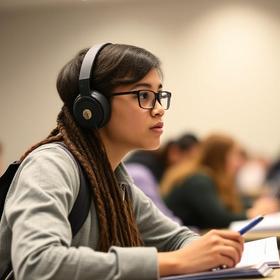Working adults have long struggled with the challenges of balancing their careers, their families, and their educational goals. Community colleges offer traditional and non-traditional students the opportunity to work toward their educational goals without the lifestyle changes that come with the traditional four-year college experience. But, even with the flexibility of early morning, evening, and even Saturday classes, adult students can find it difficult to attend even local college campuses.
Convenient, Expensive, Private On-line Universities
Private online universities, sometimes called for-profit universities, actively market the convenience of attending college courses online, anytime, from anywhere. While online universities offer a convenient option for working students, they are typically far more expensive than public community colleges. For example, the total cost of a two-year degree at the online University of Phoenix is approximately $22,000, while the same two-year degree from a community college in New York would cost an in-state resident about $9,000. Community Colleges Respond to a Need for Convenience
Richard Lock explains the 7 top benefits of online learning in this video.
Community college administrators understand that students often choose much more expensive college options because of convenience. As a result, they are taking steps to make community college more accessible to all students by introducing new modalities for online learning, including:
- Blended courses
- Online asynchronous courses
- MOOCs (Massive Open Online Courses)
- Blended Courses
Sometimes called hybrid classes, blended classes combine traditional on-campus classroom instruction with online components, such as project groups, discussion boards, or recorded lectures. Students still attend scheduled on-campus classes, but not as frequently as they would with traditional classes. There are many advantages for students in blended courses. Research has found that students are more likely to complete a blended course than they are a traditional or completely online course. The on-campus component creates a sense of accountability that encourages students to stay in a course, and the online component leaves ample time for other responsibilities. In addition, research in 2004 and 2005 shows that students in blended courses have better learning outcomes than those in other modalities. That is, students earn higher grades and are more successful in mastering skills and concepts within the courses.
A U.S. Department of Education study of blended courses conducted from 1996 to 2008 confirmed that students who were well-prepared for college were more frequently successful in blended courses than in any other modality. However, underprepared students, including those who earned GED or high school equivalency certificates instead of diplomas, and students living in poverty or with low incomes performed similarly in all types of courses. Underprepared students often require remedial skills support, such as reading and writing support. Unfortunately, research has also shown that online delivery is not the most successful approach to remedial courses. Students who need to improve basic literacy skills benefit from classroom experiences, with small groups and extended one-to-one learning with an instructor. Finally, research at the Dallas Community Colleges showed that students were much more likely to succeed in blended courses that were completely well written for the two modalities, rather than exact copies of traditional courses.
In this video from the Stanford Graduate School of Business, Andrew Ng shares his views on how MOOCs can optimize and personalize education experiences.
Blended courses that combine on-campus and online components can lead to greater success for students who are well-prepared for college when the courses have been written and developed specifically for this type of delivery. They may not be the best option for students who left high school before graduating, or for students who live in poverty or come from low-income neighborhoods.
Overview of online Asynchronous Courses
Asynchronous means not synchronous, or not at the same time. Asynchronous online courses offer students the opportunity to independently read class materials, watch or listen to instructor-delivered information, and participate in group learning activities and discussion boards without having to be present at any specific times. Students in asynchronous courses can be in different states and time zones, and students can log into the course can log in at any time within the set course period.
Research has shown that asynchronous courses are most successful when they include three different types of communication from instructors:
- Content related
- Task planning
- Social support/communication
Communication in Asynchronous Courses:
Content-related communication gives students a chance to share information with other students, and to express independent ideas and thoughts. This type of communication most often happens in discussion boards with specific discussion questions that steer the discussion. Students are assessed on their ability to directly respond to a content question posed by the instructor and by their ability to interact with other students on a specific content topic.
Asynchronous learning environments are well-suited to supporting group learning. Task-planning communication happens between students and usually involves working together to complete a single task. The instructor is involved in assignment groups and in intervention when there is conflict within the groups.
Finally, asynchronous courses are more likely to succeed when there is an opportunity for students to communicate in a way that provides social support. Online classrooms with chat areas or informal discussion boards give students an opportunity to develop collegial relationships, seek emotional support, or provide advice to one another. The most successful asynchronous classrooms offer a venue for discussions that are not related to classwork.
Outcomes of Asynchronous Learning
Research has shown that the best predictor of student success in an asynchronous classroom is the instructor’s level of engagement. Asynchronous classes must be very carefully monitored or discussions can easily go off-track. Some asynchronous classes have a discussion grading scheme that requires the instructor to assess every student's post and grant credit only for those that are related to the purpose of the discussion. In these highly regulated types of courses student retention decreases. That is, more students drop the class than drop classes that don’t assess every post. However, students who remain with the course have better learning outcomes and are more successful in earning high grades and achieving mastery of topics.
When instructors are less engaged, and post regularly, but don’t assess every student contribution, retention rises, or more students remain in the course. However, the overall average of learning outcome achievement decreases. More students complete the course, but the average grade is lower than in more strictly moderated classes.
Finally, students who did not complete traditional high school programs and those who live in poverty or in lower-income areas are more likely to choose asynchronous courses because of their perceived convenience. However, these same students are more likely to require support services and remedial courses that aren’t available through asynchronous classrooms, and are, therefore, less likely to be successful. MOOCs (Massive Open Online Course)
MOOCs are internet courses with unlimited enrollment and participation limits. They are often free and are offered by online and traditional universities. Some of the most prestigious universities in the United States, including MIT, Harvard, and Yale offer free public MOOCs of their more popular courses.
Students can sometimes earn college credit for MOOCs but usually cannot earn degrees with the hosting universities for completing the course. So, for example, a student taking a math class from Harvard might be able to earn three transferable college credits for the course but is not enrolled in a degree program at Harvard.
This video explains MOOCs.
Advantages of MOOCs
Arguably, MOOCs are delivered by some of the best professors and instructors in the country. Class content includes texts and lectures developed to reach the greatest number of people and provide comprehensive information. Students have the opportunity to interact with hundreds or thousands of others who are going through the same course.
Community colleges that offer credit to students who complete MOOCs from other institutions offer their students increased flexibility in course selection since similar courses might be offered by many different universities. Disadvantages of MOOCs
MOOCs are so large that one-to-one interaction with class instructors is nearly impossible. In some cases, all instructor content is prerecorded and class assessments and class discussions are moderated and graded by teaching assistants. So, a student might enroll in a MOOC expecting an opportunity to work with one of the most important scholars in a specific field but find that any interactions he or she has are actually with a graduate student.
Another disadvantage is that while enrolling and participating in a MOOC is often free, receiving transferable credit can be expensive, costing $150 to $300 per credit hour (or $450 to more than $1000 per average class). Low-income students may find themselves unable to pay for the credits they’ve earned, and therefore unable to transfer the credit to their community college programs.
Conclusion – Online Learning in Community Colleges
Online learning options have the potential to make community college even more accessible to working adults. However, student preparation, background, and even income can be predictors of student success. Students who need support services or have not completed traditional K-12 education may find it difficult to succeed in online courses. Students sometimes confuse flexibility with rigor and are not prepared for the commitment necessary to successfully complete a college course. When community colleges carefully assess student readiness, student retention, and student success increase.
Questions? Contact us on Facebook. @communitycollegereview















